The Evolution of Spoken Standard English in the Victorian Era
VerifiedAdded on 2022/09/12
|10
|2856
|24
Essay
AI Summary
This essay provides an analysis of the spoken standard of English during the Victorian period, specifically from 1500 onwards, with a focus on the relationship between 'Standard English' and 'non-standard' varieties. The paper examines the social and economic influences on the development of Standard English, the attitudes of speakers towards it, and any resistance to its establishment. It discusses the development of written English during the mid and late Victorian periods, highlighting the diversification in subjects and settings of novels, the role of social class, and the influence of writers' approaches to regional and social variations. The essay also explores the impact of women writers and their contributions to the literary landscape of the time. The discussion also considers the Aestheticism and Decadence movement and the writings of prominent figures like Alfred Lord Tennyson. The essay uses scholarly sources to support its arguments and provides a comprehensive overview of the evolution of English during this significant period.
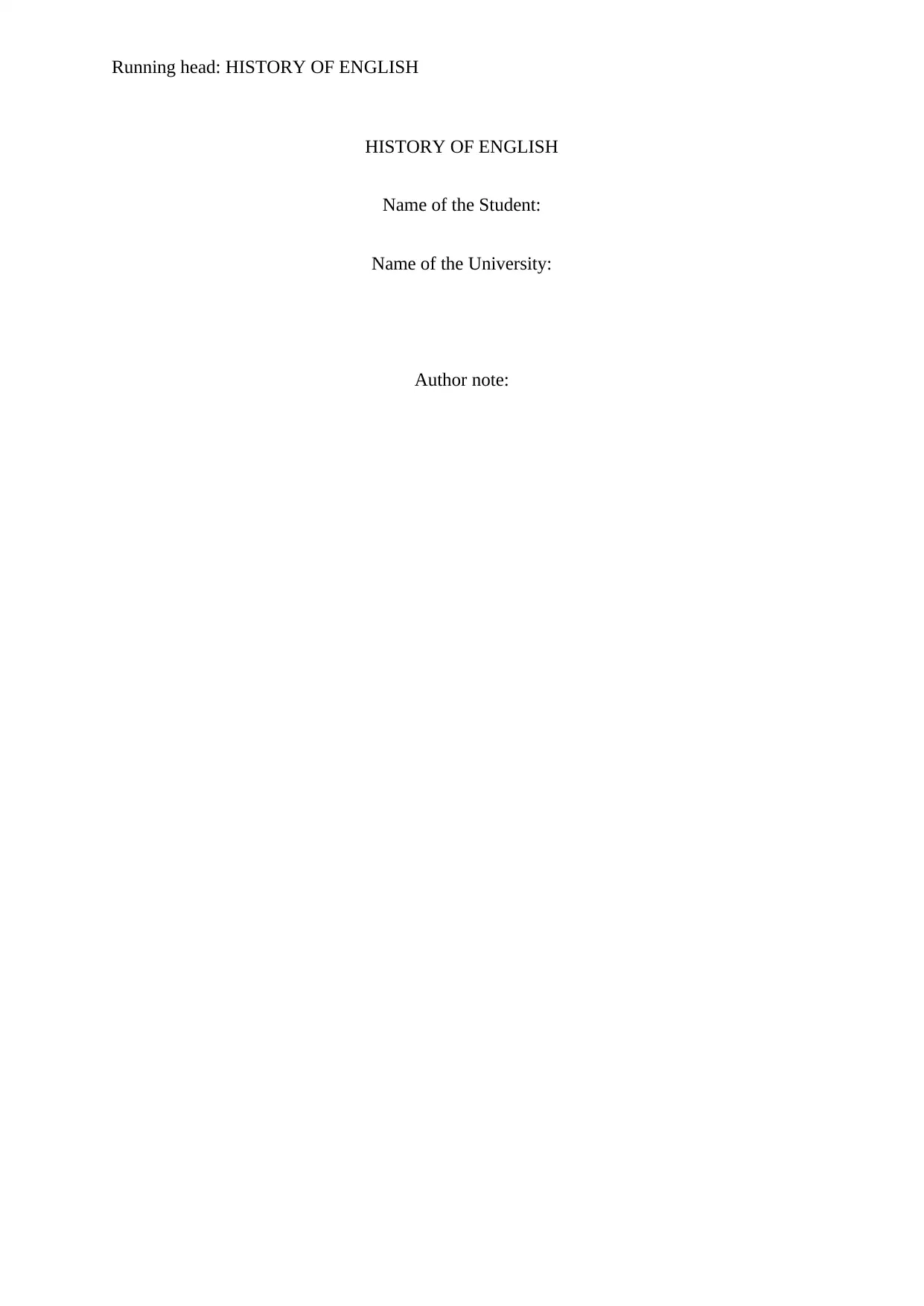
Running head: HISTORY OF ENGLISH
HISTORY OF ENGLISH
Name of the Student:
Name of the University:
Author note:
HISTORY OF ENGLISH
Name of the Student:
Name of the University:
Author note:
Paraphrase This Document
Need a fresh take? Get an instant paraphrase of this document with our AI Paraphraser
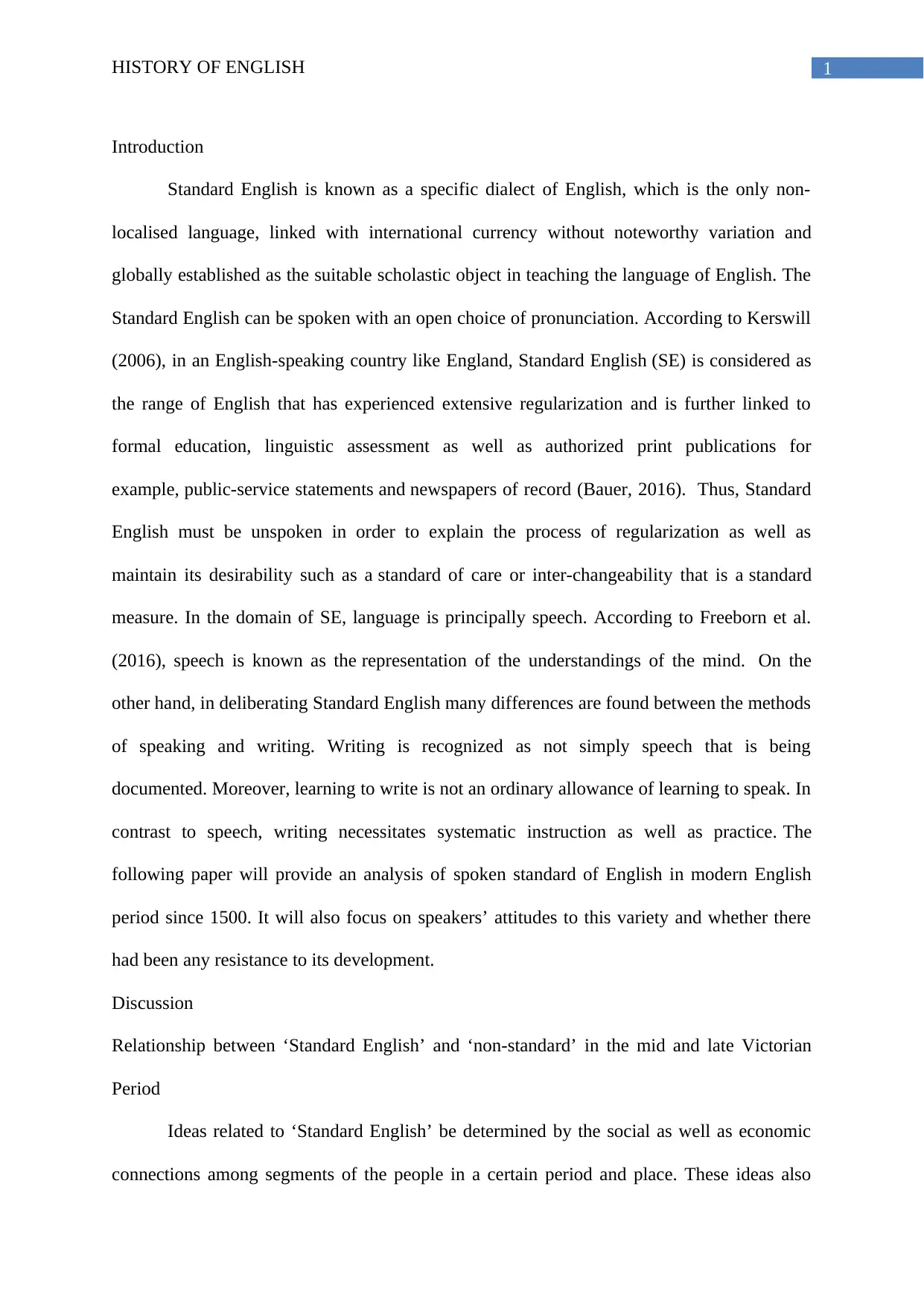
1HISTORY OF ENGLISH
Introduction
Standard English is known as a specific dialect of English, which is the only non-
localised language, linked with international currency without noteworthy variation and
globally established as the suitable scholastic object in teaching the language of English. The
Standard English can be spoken with an open choice of pronunciation. According to Kerswill
(2006), in an English-speaking country like England, Standard English (SE) is considered as
the range of English that has experienced extensive regularization and is further linked to
formal education, linguistic assessment as well as authorized print publications for
example, public-service statements and newspapers of record (Bauer, 2016). Thus, Standard
English must be unspoken in order to explain the process of regularization as well as
maintain its desirability such as a standard of care or inter-changeability that is a standard
measure. In the domain of SE, language is principally speech. According to Freeborn et al.
(2016), speech is known as the representation of the understandings of the mind. On the
other hand, in deliberating Standard English many differences are found between the methods
of speaking and writing. Writing is recognized as not simply speech that is being
documented. Moreover, learning to write is not an ordinary allowance of learning to speak. In
contrast to speech, writing necessitates systematic instruction as well as practice. The
following paper will provide an analysis of spoken standard of English in modern English
period since 1500. It will also focus on speakers’ attitudes to this variety and whether there
had been any resistance to its development.
Discussion
Relationship between ‘Standard English’ and ‘non-standard’ in the mid and late Victorian
Period
Ideas related to ‘Standard English’ be determined by the social as well as economic
connections among segments of the people in a certain period and place. These ideas also
Introduction
Standard English is known as a specific dialect of English, which is the only non-
localised language, linked with international currency without noteworthy variation and
globally established as the suitable scholastic object in teaching the language of English. The
Standard English can be spoken with an open choice of pronunciation. According to Kerswill
(2006), in an English-speaking country like England, Standard English (SE) is considered as
the range of English that has experienced extensive regularization and is further linked to
formal education, linguistic assessment as well as authorized print publications for
example, public-service statements and newspapers of record (Bauer, 2016). Thus, Standard
English must be unspoken in order to explain the process of regularization as well as
maintain its desirability such as a standard of care or inter-changeability that is a standard
measure. In the domain of SE, language is principally speech. According to Freeborn et al.
(2016), speech is known as the representation of the understandings of the mind. On the
other hand, in deliberating Standard English many differences are found between the methods
of speaking and writing. Writing is recognized as not simply speech that is being
documented. Moreover, learning to write is not an ordinary allowance of learning to speak. In
contrast to speech, writing necessitates systematic instruction as well as practice. The
following paper will provide an analysis of spoken standard of English in modern English
period since 1500. It will also focus on speakers’ attitudes to this variety and whether there
had been any resistance to its development.
Discussion
Relationship between ‘Standard English’ and ‘non-standard’ in the mid and late Victorian
Period
Ideas related to ‘Standard English’ be determined by the social as well as economic
connections among segments of the people in a certain period and place. These ideas also
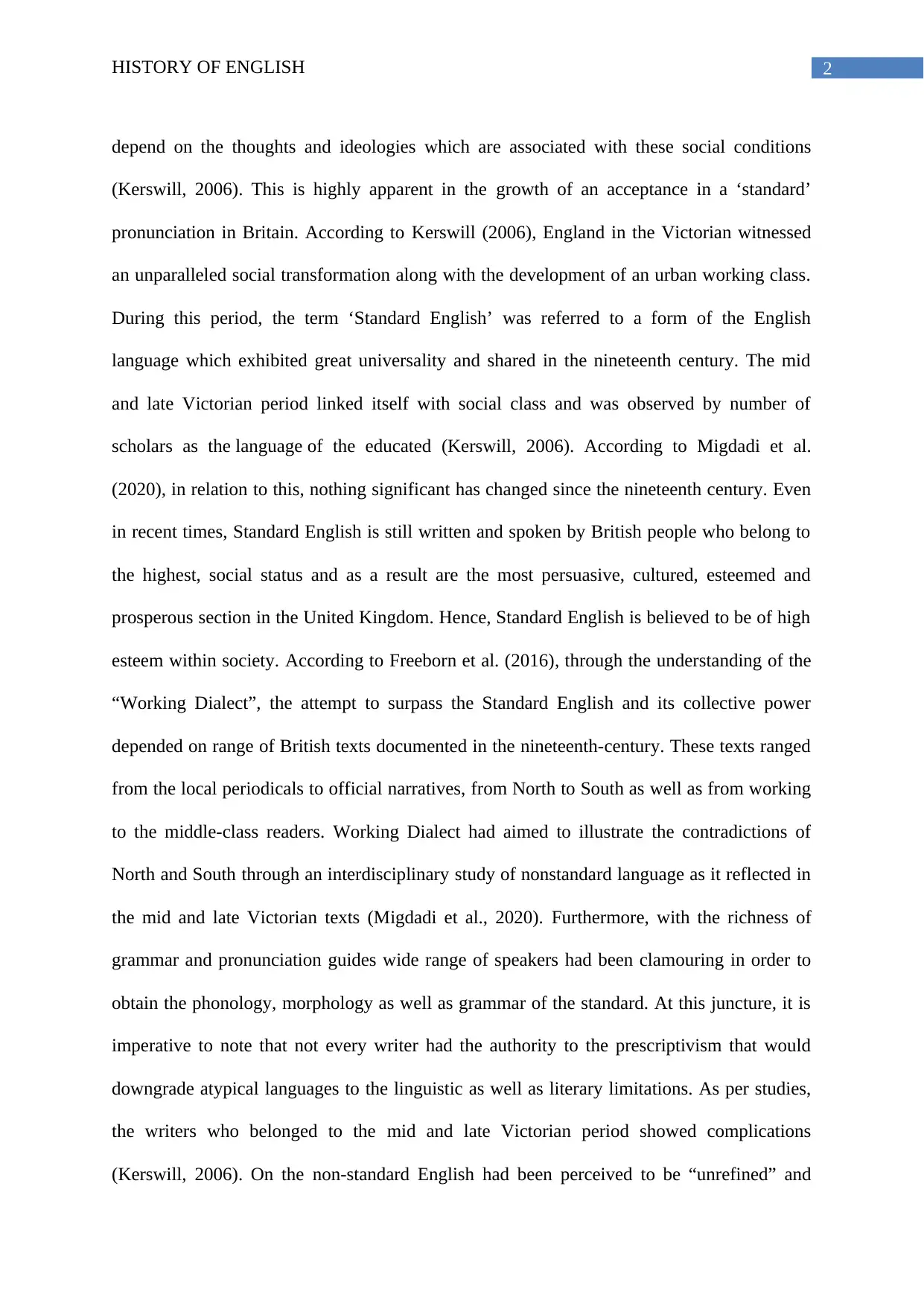
2HISTORY OF ENGLISH
depend on the thoughts and ideologies which are associated with these social conditions
(Kerswill, 2006). This is highly apparent in the growth of an acceptance in a ‘standard’
pronunciation in Britain. According to Kerswill (2006), England in the Victorian witnessed
an unparalleled social transformation along with the development of an urban working class.
During this period, the term ‘Standard English’ was referred to a form of the English
language which exhibited great universality and shared in the nineteenth century. The mid
and late Victorian period linked itself with social class and was observed by number of
scholars as the language of the educated (Kerswill, 2006). According to Migdadi et al.
(2020), in relation to this, nothing significant has changed since the nineteenth century. Even
in recent times, Standard English is still written and spoken by British people who belong to
the highest, social status and as a result are the most persuasive, cultured, esteemed and
prosperous section in the United Kingdom. Hence, Standard English is believed to be of high
esteem within society. According to Freeborn et al. (2016), through the understanding of the
“Working Dialect”, the attempt to surpass the Standard English and its collective power
depended on range of British texts documented in the nineteenth-century. These texts ranged
from the local periodicals to official narratives, from North to South as well as from working
to the middle-class readers. Working Dialect had aimed to illustrate the contradictions of
North and South through an interdisciplinary study of nonstandard language as it reflected in
the mid and late Victorian texts (Migdadi et al., 2020). Furthermore, with the richness of
grammar and pronunciation guides wide range of speakers had been clamouring in order to
obtain the phonology, morphology as well as grammar of the standard. At this juncture, it is
imperative to note that not every writer had the authority to the prescriptivism that would
downgrade atypical languages to the linguistic as well as literary limitations. As per studies,
the writers who belonged to the mid and late Victorian period showed complications
(Kerswill, 2006). On the non-standard English had been perceived to be “unrefined” and
depend on the thoughts and ideologies which are associated with these social conditions
(Kerswill, 2006). This is highly apparent in the growth of an acceptance in a ‘standard’
pronunciation in Britain. According to Kerswill (2006), England in the Victorian witnessed
an unparalleled social transformation along with the development of an urban working class.
During this period, the term ‘Standard English’ was referred to a form of the English
language which exhibited great universality and shared in the nineteenth century. The mid
and late Victorian period linked itself with social class and was observed by number of
scholars as the language of the educated (Kerswill, 2006). According to Migdadi et al.
(2020), in relation to this, nothing significant has changed since the nineteenth century. Even
in recent times, Standard English is still written and spoken by British people who belong to
the highest, social status and as a result are the most persuasive, cultured, esteemed and
prosperous section in the United Kingdom. Hence, Standard English is believed to be of high
esteem within society. According to Freeborn et al. (2016), through the understanding of the
“Working Dialect”, the attempt to surpass the Standard English and its collective power
depended on range of British texts documented in the nineteenth-century. These texts ranged
from the local periodicals to official narratives, from North to South as well as from working
to the middle-class readers. Working Dialect had aimed to illustrate the contradictions of
North and South through an interdisciplinary study of nonstandard language as it reflected in
the mid and late Victorian texts (Migdadi et al., 2020). Furthermore, with the richness of
grammar and pronunciation guides wide range of speakers had been clamouring in order to
obtain the phonology, morphology as well as grammar of the standard. At this juncture, it is
imperative to note that not every writer had the authority to the prescriptivism that would
downgrade atypical languages to the linguistic as well as literary limitations. As per studies,
the writers who belonged to the mid and late Victorian period showed complications
(Kerswill, 2006). On the non-standard English had been perceived to be “unrefined” and
⊘ This is a preview!⊘
Do you want full access?
Subscribe today to unlock all pages.

Trusted by 1+ million students worldwide
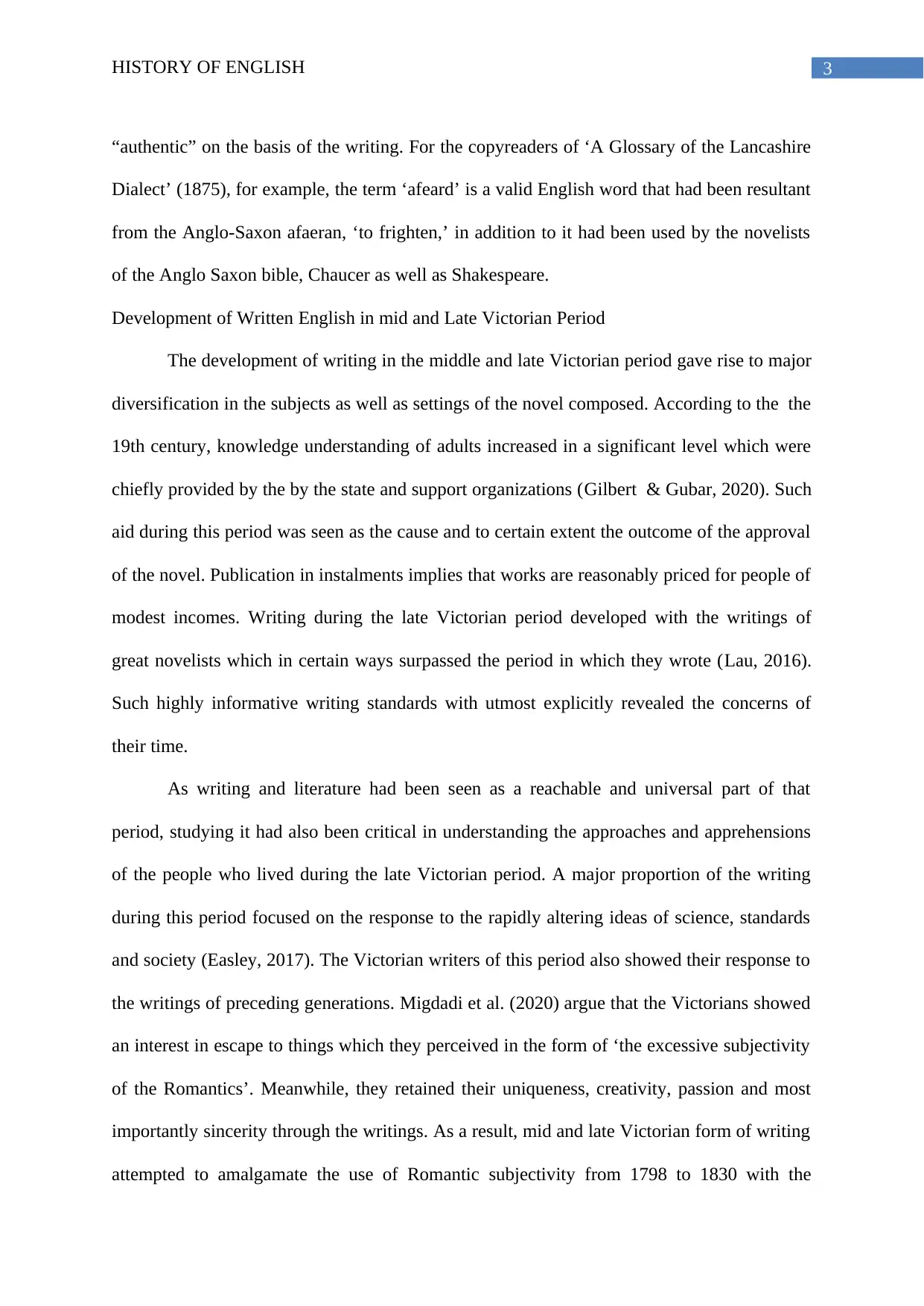
3HISTORY OF ENGLISH
“authentic” on the basis of the writing. For the copyreaders of ‘A Glossary of the Lancashire
Dialect’ (1875), for example, the term ‘afeard’ is a valid English word that had been resultant
from the Anglo-Saxon afaeran, ‘to frighten,’ in addition to it had been used by the novelists
of the Anglo Saxon bible, Chaucer as well as Shakespeare.
Development of Written English in mid and Late Victorian Period
The development of writing in the middle and late Victorian period gave rise to major
diversification in the subjects as well as settings of the novel composed. According to the the
19th century, knowledge understanding of adults increased in a significant level which were
chiefly provided by the by the state and support organizations (Gilbert & Gubar, 2020). Such
aid during this period was seen as the cause and to certain extent the outcome of the approval
of the novel. Publication in instalments implies that works are reasonably priced for people of
modest incomes. Writing during the late Victorian period developed with the writings of
great novelists which in certain ways surpassed the period in which they wrote (Lau, 2016).
Such highly informative writing standards with utmost explicitly revealed the concerns of
their time.
As writing and literature had been seen as a reachable and universal part of that
period, studying it had also been critical in understanding the approaches and apprehensions
of the people who lived during the late Victorian period. A major proportion of the writing
during this period focused on the response to the rapidly altering ideas of science, standards
and society (Easley, 2017). The Victorian writers of this period also showed their response to
the writings of preceding generations. Migdadi et al. (2020) argue that the Victorians showed
an interest in escape to things which they perceived in the form of ‘the excessive subjectivity
of the Romantics’. Meanwhile, they retained their uniqueness, creativity, passion and most
importantly sincerity through the writings. As a result, mid and late Victorian form of writing
attempted to amalgamate the use of Romantic subjectivity from 1798 to 1830 with the
“authentic” on the basis of the writing. For the copyreaders of ‘A Glossary of the Lancashire
Dialect’ (1875), for example, the term ‘afeard’ is a valid English word that had been resultant
from the Anglo-Saxon afaeran, ‘to frighten,’ in addition to it had been used by the novelists
of the Anglo Saxon bible, Chaucer as well as Shakespeare.
Development of Written English in mid and Late Victorian Period
The development of writing in the middle and late Victorian period gave rise to major
diversification in the subjects as well as settings of the novel composed. According to the the
19th century, knowledge understanding of adults increased in a significant level which were
chiefly provided by the by the state and support organizations (Gilbert & Gubar, 2020). Such
aid during this period was seen as the cause and to certain extent the outcome of the approval
of the novel. Publication in instalments implies that works are reasonably priced for people of
modest incomes. Writing during the late Victorian period developed with the writings of
great novelists which in certain ways surpassed the period in which they wrote (Lau, 2016).
Such highly informative writing standards with utmost explicitly revealed the concerns of
their time.
As writing and literature had been seen as a reachable and universal part of that
period, studying it had also been critical in understanding the approaches and apprehensions
of the people who lived during the late Victorian period. A major proportion of the writing
during this period focused on the response to the rapidly altering ideas of science, standards
and society (Easley, 2017). The Victorian writers of this period also showed their response to
the writings of preceding generations. Migdadi et al. (2020) argue that the Victorians showed
an interest in escape to things which they perceived in the form of ‘the excessive subjectivity
of the Romantics’. Meanwhile, they retained their uniqueness, creativity, passion and most
importantly sincerity through the writings. As a result, mid and late Victorian form of writing
attempted to amalgamate the use of Romantic subjectivity from 1798 to 1830 with the
Paraphrase This Document
Need a fresh take? Get an instant paraphrase of this document with our AI Paraphraser
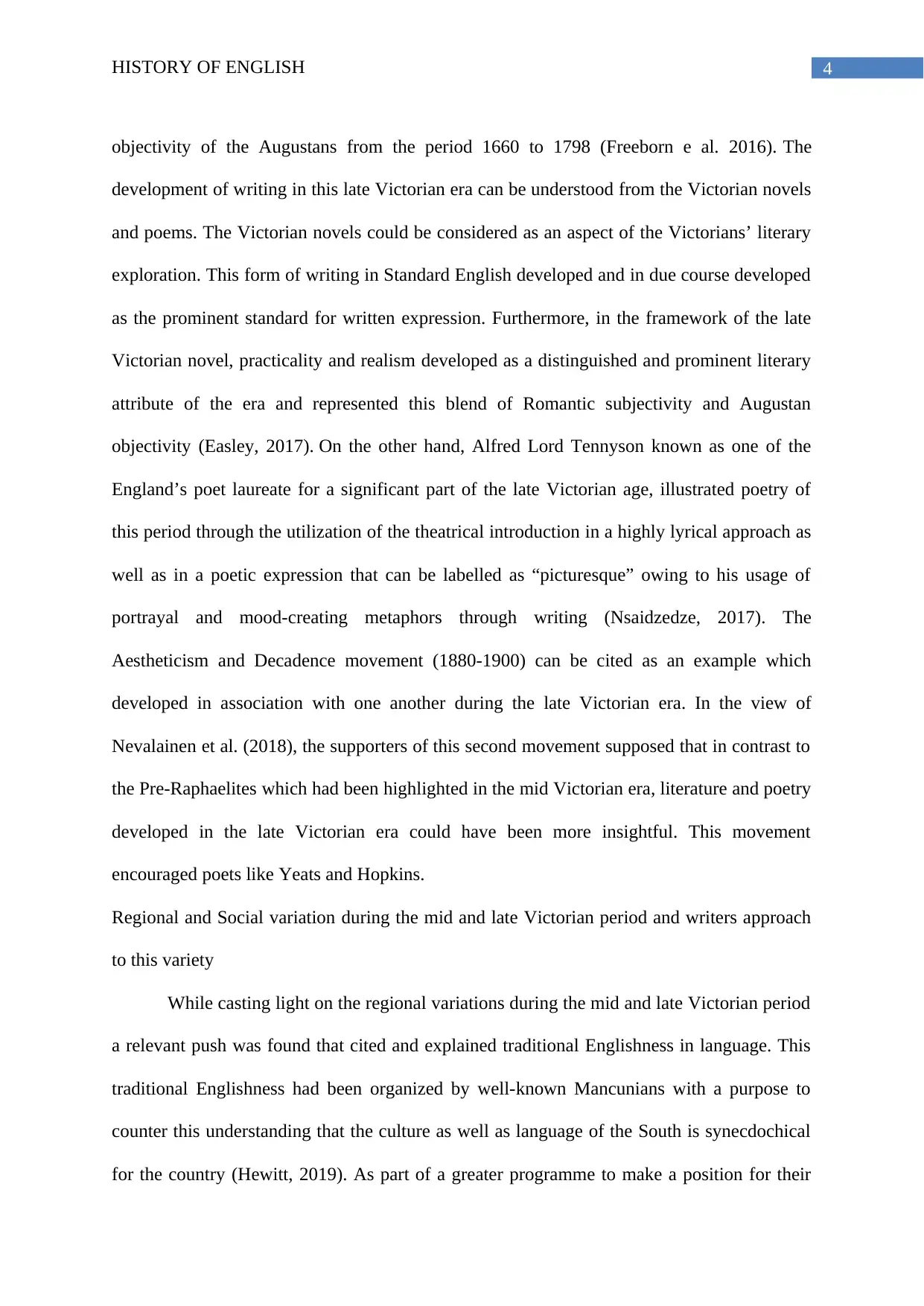
4HISTORY OF ENGLISH
objectivity of the Augustans from the period 1660 to 1798 (Freeborn e al. 2016). The
development of writing in this late Victorian era can be understood from the Victorian novels
and poems. The Victorian novels could be considered as an aspect of the Victorians’ literary
exploration. This form of writing in Standard English developed and in due course developed
as the prominent standard for written expression. Furthermore, in the framework of the late
Victorian novel, practicality and realism developed as a distinguished and prominent literary
attribute of the era and represented this blend of Romantic subjectivity and Augustan
objectivity (Easley, 2017). On the other hand, Alfred Lord Tennyson known as one of the
England’s poet laureate for a significant part of the late Victorian age, illustrated poetry of
this period through the utilization of the theatrical introduction in a highly lyrical approach as
well as in a poetic expression that can be labelled as “picturesque” owing to his usage of
portrayal and mood-creating metaphors through writing (Nsaidzedze, 2017). The
Aestheticism and Decadence movement (1880-1900) can be cited as an example which
developed in association with one another during the late Victorian era. In the view of
Nevalainen et al. (2018), the supporters of this second movement supposed that in contrast to
the Pre-Raphaelites which had been highlighted in the mid Victorian era, literature and poetry
developed in the late Victorian era could have been more insightful. This movement
encouraged poets like Yeats and Hopkins.
Regional and Social variation during the mid and late Victorian period and writers approach
to this variety
While casting light on the regional variations during the mid and late Victorian period
a relevant push was found that cited and explained traditional Englishness in language. This
traditional Englishness had been organized by well-known Mancunians with a purpose to
counter this understanding that the culture as well as language of the South is synecdochical
for the country (Hewitt, 2019). As part of a greater programme to make a position for their
objectivity of the Augustans from the period 1660 to 1798 (Freeborn e al. 2016). The
development of writing in this late Victorian era can be understood from the Victorian novels
and poems. The Victorian novels could be considered as an aspect of the Victorians’ literary
exploration. This form of writing in Standard English developed and in due course developed
as the prominent standard for written expression. Furthermore, in the framework of the late
Victorian novel, practicality and realism developed as a distinguished and prominent literary
attribute of the era and represented this blend of Romantic subjectivity and Augustan
objectivity (Easley, 2017). On the other hand, Alfred Lord Tennyson known as one of the
England’s poet laureate for a significant part of the late Victorian age, illustrated poetry of
this period through the utilization of the theatrical introduction in a highly lyrical approach as
well as in a poetic expression that can be labelled as “picturesque” owing to his usage of
portrayal and mood-creating metaphors through writing (Nsaidzedze, 2017). The
Aestheticism and Decadence movement (1880-1900) can be cited as an example which
developed in association with one another during the late Victorian era. In the view of
Nevalainen et al. (2018), the supporters of this second movement supposed that in contrast to
the Pre-Raphaelites which had been highlighted in the mid Victorian era, literature and poetry
developed in the late Victorian era could have been more insightful. This movement
encouraged poets like Yeats and Hopkins.
Regional and Social variation during the mid and late Victorian period and writers approach
to this variety
While casting light on the regional variations during the mid and late Victorian period
a relevant push was found that cited and explained traditional Englishness in language. This
traditional Englishness had been organized by well-known Mancunians with a purpose to
counter this understanding that the culture as well as language of the South is synecdochical
for the country (Hewitt, 2019). As part of a greater programme to make a position for their
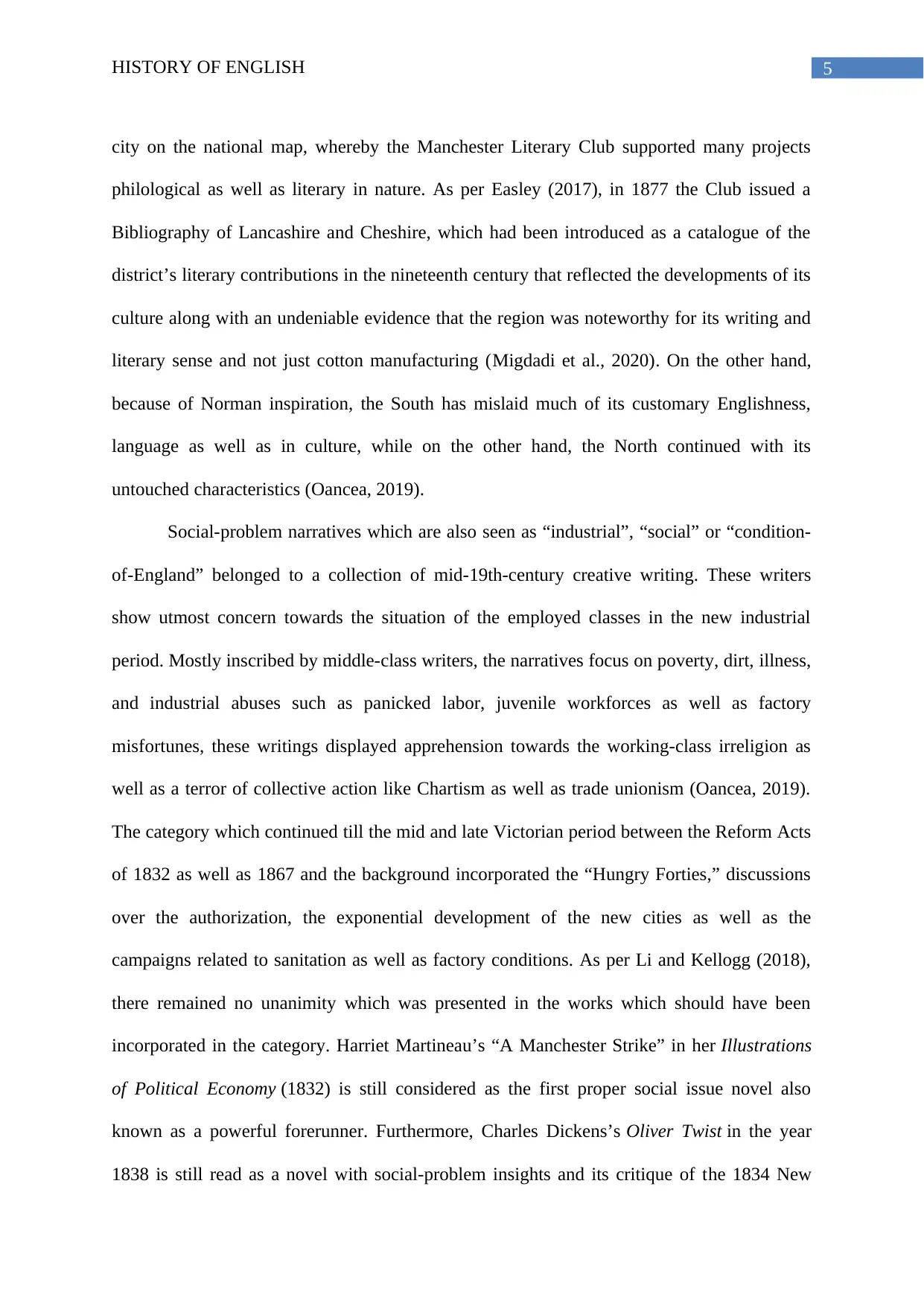
5HISTORY OF ENGLISH
city on the national map, whereby the Manchester Literary Club supported many projects
philological as well as literary in nature. As per Easley (2017), in 1877 the Club issued a
Bibliography of Lancashire and Cheshire, which had been introduced as a catalogue of the
district’s literary contributions in the nineteenth century that reflected the developments of its
culture along with an undeniable evidence that the region was noteworthy for its writing and
literary sense and not just cotton manufacturing (Migdadi et al., 2020). On the other hand,
because of Norman inspiration, the South has mislaid much of its customary Englishness,
language as well as in culture, while on the other hand, the North continued with its
untouched characteristics (Oancea, 2019).
Social-problem narratives which are also seen as “industrial”, “social” or “condition-
of-England” belonged to a collection of mid-19th-century creative writing. These writers
show utmost concern towards the situation of the employed classes in the new industrial
period. Mostly inscribed by middle-class writers, the narratives focus on poverty, dirt, illness,
and industrial abuses such as panicked labor, juvenile workforces as well as factory
misfortunes, these writings displayed apprehension towards the working-class irreligion as
well as a terror of collective action like Chartism as well as trade unionism (Oancea, 2019).
The category which continued till the mid and late Victorian period between the Reform Acts
of 1832 as well as 1867 and the background incorporated the “Hungry Forties,” discussions
over the authorization, the exponential development of the new cities as well as the
campaigns related to sanitation as well as factory conditions. As per Li and Kellogg (2018),
there remained no unanimity which was presented in the works which should have been
incorporated in the category. Harriet Martineau’s “A Manchester Strike” in her Illustrations
of Political Economy (1832) is still considered as the first proper social issue novel also
known as a powerful forerunner. Furthermore, Charles Dickens’s Oliver Twist in the year
1838 is still read as a novel with social-problem insights and its critique of the 1834 New
city on the national map, whereby the Manchester Literary Club supported many projects
philological as well as literary in nature. As per Easley (2017), in 1877 the Club issued a
Bibliography of Lancashire and Cheshire, which had been introduced as a catalogue of the
district’s literary contributions in the nineteenth century that reflected the developments of its
culture along with an undeniable evidence that the region was noteworthy for its writing and
literary sense and not just cotton manufacturing (Migdadi et al., 2020). On the other hand,
because of Norman inspiration, the South has mislaid much of its customary Englishness,
language as well as in culture, while on the other hand, the North continued with its
untouched characteristics (Oancea, 2019).
Social-problem narratives which are also seen as “industrial”, “social” or “condition-
of-England” belonged to a collection of mid-19th-century creative writing. These writers
show utmost concern towards the situation of the employed classes in the new industrial
period. Mostly inscribed by middle-class writers, the narratives focus on poverty, dirt, illness,
and industrial abuses such as panicked labor, juvenile workforces as well as factory
misfortunes, these writings displayed apprehension towards the working-class irreligion as
well as a terror of collective action like Chartism as well as trade unionism (Oancea, 2019).
The category which continued till the mid and late Victorian period between the Reform Acts
of 1832 as well as 1867 and the background incorporated the “Hungry Forties,” discussions
over the authorization, the exponential development of the new cities as well as the
campaigns related to sanitation as well as factory conditions. As per Li and Kellogg (2018),
there remained no unanimity which was presented in the works which should have been
incorporated in the category. Harriet Martineau’s “A Manchester Strike” in her Illustrations
of Political Economy (1832) is still considered as the first proper social issue novel also
known as a powerful forerunner. Furthermore, Charles Dickens’s Oliver Twist in the year
1838 is still read as a novel with social-problem insights and its critique of the 1834 New
⊘ This is a preview!⊘
Do you want full access?
Subscribe today to unlock all pages.

Trusted by 1+ million students worldwide
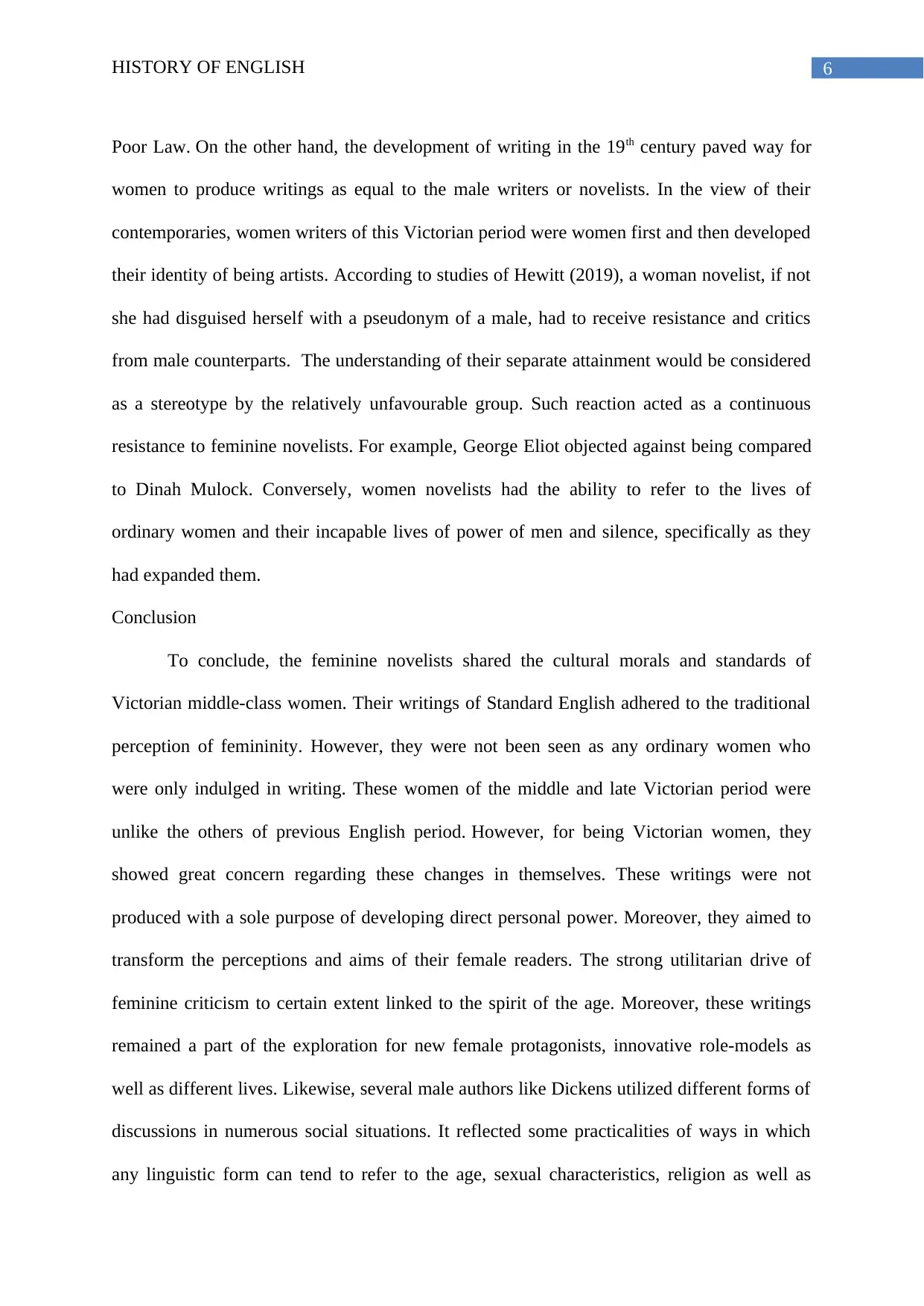
6HISTORY OF ENGLISH
Poor Law. On the other hand, the development of writing in the 19th century paved way for
women to produce writings as equal to the male writers or novelists. In the view of their
contemporaries, women writers of this Victorian period were women first and then developed
their identity of being artists. According to studies of Hewitt (2019), a woman novelist, if not
she had disguised herself with a pseudonym of a male, had to receive resistance and critics
from male counterparts. The understanding of their separate attainment would be considered
as a stereotype by the relatively unfavourable group. Such reaction acted as a continuous
resistance to feminine novelists. For example, George Eliot objected against being compared
to Dinah Mulock. Conversely, women novelists had the ability to refer to the lives of
ordinary women and their incapable lives of power of men and silence, specifically as they
had expanded them.
Conclusion
To conclude, the feminine novelists shared the cultural morals and standards of
Victorian middle-class women. Their writings of Standard English adhered to the traditional
perception of femininity. However, they were not been seen as any ordinary women who
were only indulged in writing. These women of the middle and late Victorian period were
unlike the others of previous English period. However, for being Victorian women, they
showed great concern regarding these changes in themselves. These writings were not
produced with a sole purpose of developing direct personal power. Moreover, they aimed to
transform the perceptions and aims of their female readers. The strong utilitarian drive of
feminine criticism to certain extent linked to the spirit of the age. Moreover, these writings
remained a part of the exploration for new female protagonists, innovative role-models as
well as different lives. Likewise, several male authors like Dickens utilized different forms of
discussions in numerous social situations. It reflected some practicalities of ways in which
any linguistic form can tend to refer to the age, sexual characteristics, religion as well as
Poor Law. On the other hand, the development of writing in the 19th century paved way for
women to produce writings as equal to the male writers or novelists. In the view of their
contemporaries, women writers of this Victorian period were women first and then developed
their identity of being artists. According to studies of Hewitt (2019), a woman novelist, if not
she had disguised herself with a pseudonym of a male, had to receive resistance and critics
from male counterparts. The understanding of their separate attainment would be considered
as a stereotype by the relatively unfavourable group. Such reaction acted as a continuous
resistance to feminine novelists. For example, George Eliot objected against being compared
to Dinah Mulock. Conversely, women novelists had the ability to refer to the lives of
ordinary women and their incapable lives of power of men and silence, specifically as they
had expanded them.
Conclusion
To conclude, the feminine novelists shared the cultural morals and standards of
Victorian middle-class women. Their writings of Standard English adhered to the traditional
perception of femininity. However, they were not been seen as any ordinary women who
were only indulged in writing. These women of the middle and late Victorian period were
unlike the others of previous English period. However, for being Victorian women, they
showed great concern regarding these changes in themselves. These writings were not
produced with a sole purpose of developing direct personal power. Moreover, they aimed to
transform the perceptions and aims of their female readers. The strong utilitarian drive of
feminine criticism to certain extent linked to the spirit of the age. Moreover, these writings
remained a part of the exploration for new female protagonists, innovative role-models as
well as different lives. Likewise, several male authors like Dickens utilized different forms of
discussions in numerous social situations. It reflected some practicalities of ways in which
any linguistic form can tend to refer to the age, sexual characteristics, religion as well as
Paraphrase This Document
Need a fresh take? Get an instant paraphrase of this document with our AI Paraphraser
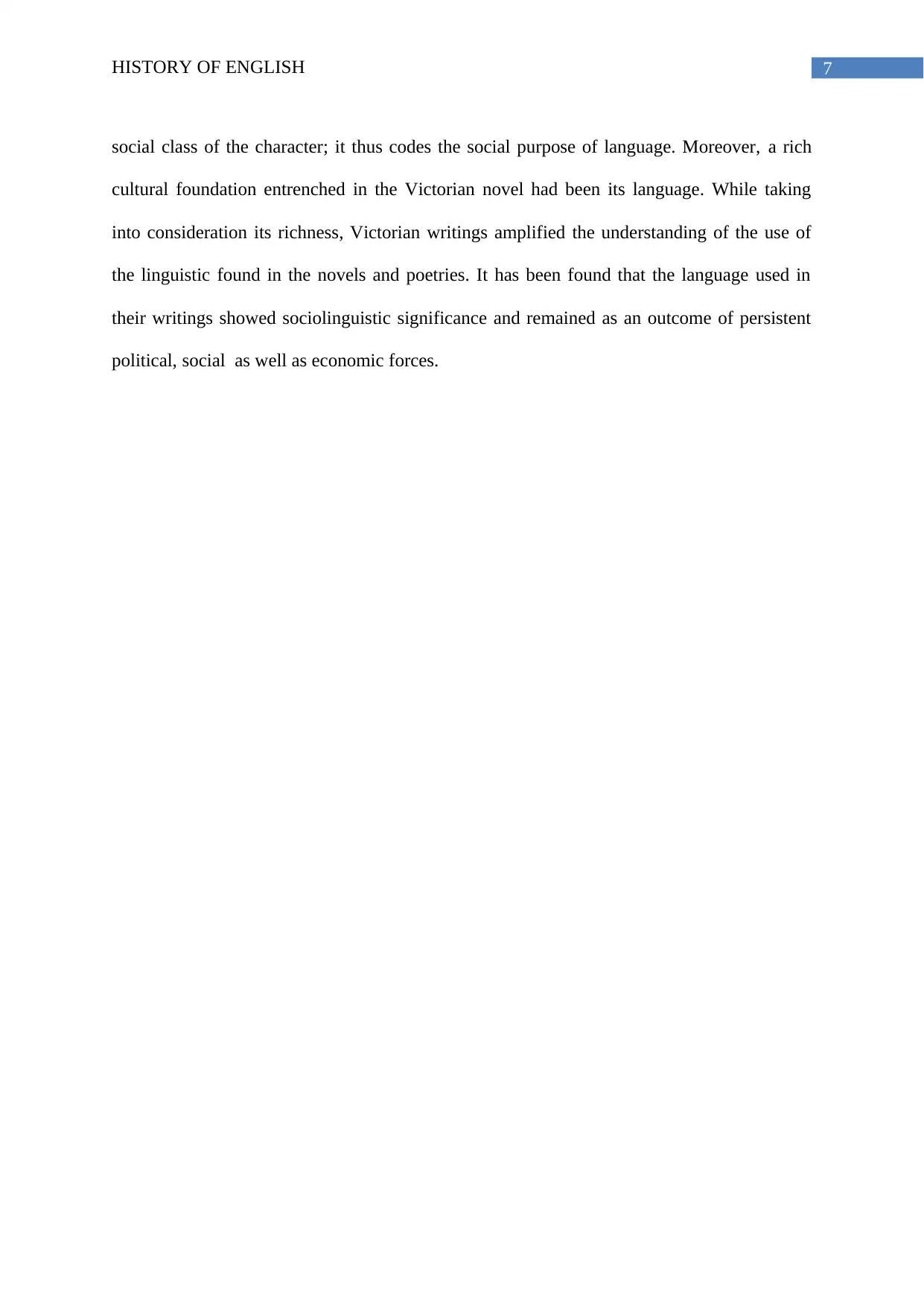
7HISTORY OF ENGLISH
social class of the character; it thus codes the social purpose of language. Moreover, a rich
cultural foundation entrenched in the Victorian novel had been its language. While taking
into consideration its richness, Victorian writings amplified the understanding of the use of
the linguistic found in the novels and poetries. It has been found that the language used in
their writings showed sociolinguistic significance and remained as an outcome of persistent
political, social as well as economic forces.
social class of the character; it thus codes the social purpose of language. Moreover, a rich
cultural foundation entrenched in the Victorian novel had been its language. While taking
into consideration its richness, Victorian writings amplified the understanding of the use of
the linguistic found in the novels and poetries. It has been found that the language used in
their writings showed sociolinguistic significance and remained as an outcome of persistent
political, social as well as economic forces.
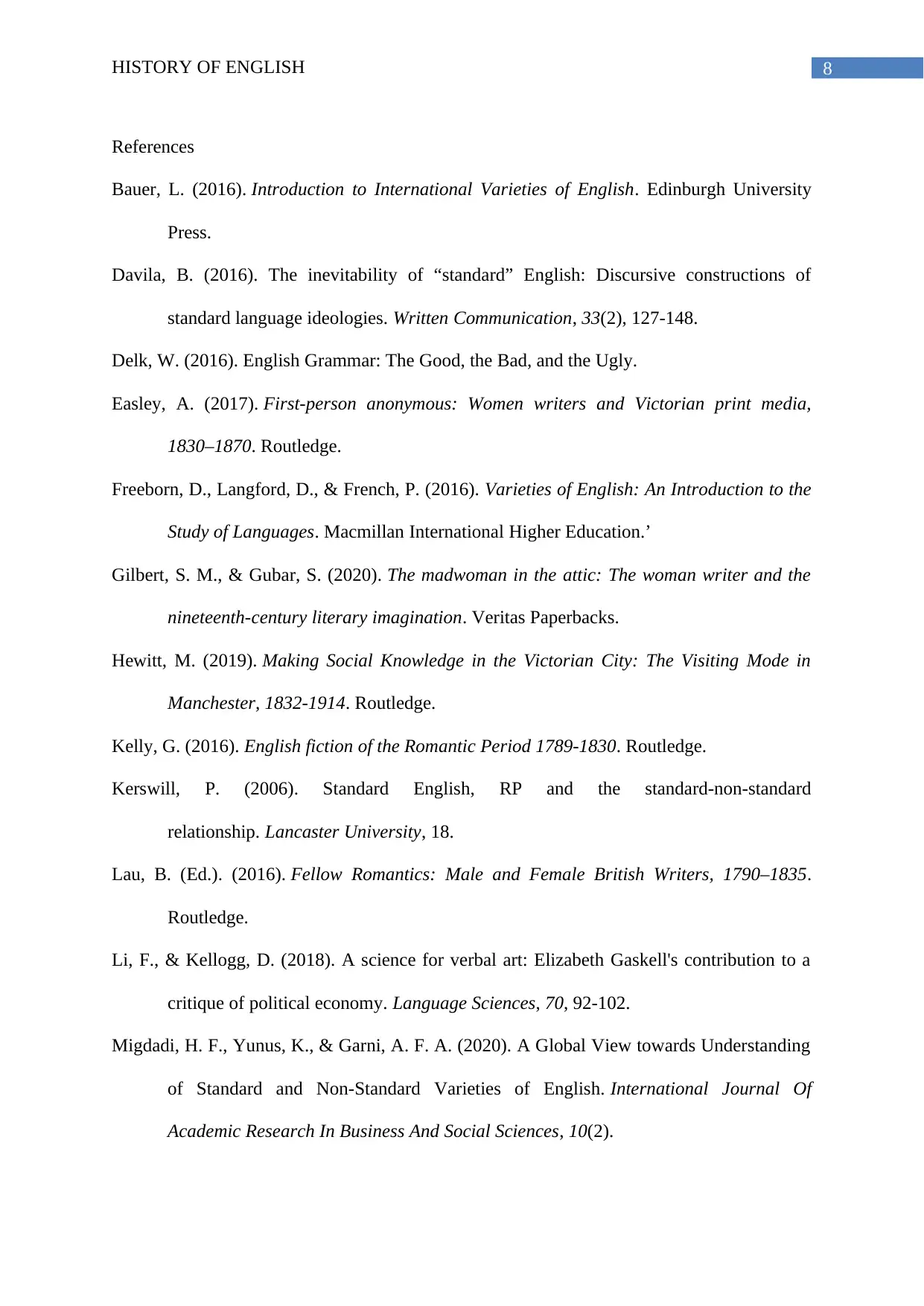
8HISTORY OF ENGLISH
References
Bauer, L. (2016). Introduction to International Varieties of English. Edinburgh University
Press.
Davila, B. (2016). The inevitability of “standard” English: Discursive constructions of
standard language ideologies. Written Communication, 33(2), 127-148.
Delk, W. (2016). English Grammar: The Good, the Bad, and the Ugly.
Easley, A. (2017). First-person anonymous: Women writers and Victorian print media,
1830–1870. Routledge.
Freeborn, D., Langford, D., & French, P. (2016). Varieties of English: An Introduction to the
Study of Languages. Macmillan International Higher Education.’
Gilbert, S. M., & Gubar, S. (2020). The madwoman in the attic: The woman writer and the
nineteenth-century literary imagination. Veritas Paperbacks.
Hewitt, M. (2019). Making Social Knowledge in the Victorian City: The Visiting Mode in
Manchester, 1832-1914. Routledge.
Kelly, G. (2016). English fiction of the Romantic Period 1789-1830. Routledge.
Kerswill, P. (2006). Standard English, RP and the standard-non-standard
relationship. Lancaster University, 18.
Lau, B. (Ed.). (2016). Fellow Romantics: Male and Female British Writers, 1790–1835.
Routledge.
Li, F., & Kellogg, D. (2018). A science for verbal art: Elizabeth Gaskell's contribution to a
critique of political economy. Language Sciences, 70, 92-102.
Migdadi, H. F., Yunus, K., & Garni, A. F. A. (2020). A Global View towards Understanding
of Standard and Non-Standard Varieties of English. International Journal Of
Academic Research In Business And Social Sciences, 10(2).
References
Bauer, L. (2016). Introduction to International Varieties of English. Edinburgh University
Press.
Davila, B. (2016). The inevitability of “standard” English: Discursive constructions of
standard language ideologies. Written Communication, 33(2), 127-148.
Delk, W. (2016). English Grammar: The Good, the Bad, and the Ugly.
Easley, A. (2017). First-person anonymous: Women writers and Victorian print media,
1830–1870. Routledge.
Freeborn, D., Langford, D., & French, P. (2016). Varieties of English: An Introduction to the
Study of Languages. Macmillan International Higher Education.’
Gilbert, S. M., & Gubar, S. (2020). The madwoman in the attic: The woman writer and the
nineteenth-century literary imagination. Veritas Paperbacks.
Hewitt, M. (2019). Making Social Knowledge in the Victorian City: The Visiting Mode in
Manchester, 1832-1914. Routledge.
Kelly, G. (2016). English fiction of the Romantic Period 1789-1830. Routledge.
Kerswill, P. (2006). Standard English, RP and the standard-non-standard
relationship. Lancaster University, 18.
Lau, B. (Ed.). (2016). Fellow Romantics: Male and Female British Writers, 1790–1835.
Routledge.
Li, F., & Kellogg, D. (2018). A science for verbal art: Elizabeth Gaskell's contribution to a
critique of political economy. Language Sciences, 70, 92-102.
Migdadi, H. F., Yunus, K., & Garni, A. F. A. (2020). A Global View towards Understanding
of Standard and Non-Standard Varieties of English. International Journal Of
Academic Research In Business And Social Sciences, 10(2).
⊘ This is a preview!⊘
Do you want full access?
Subscribe today to unlock all pages.

Trusted by 1+ million students worldwide
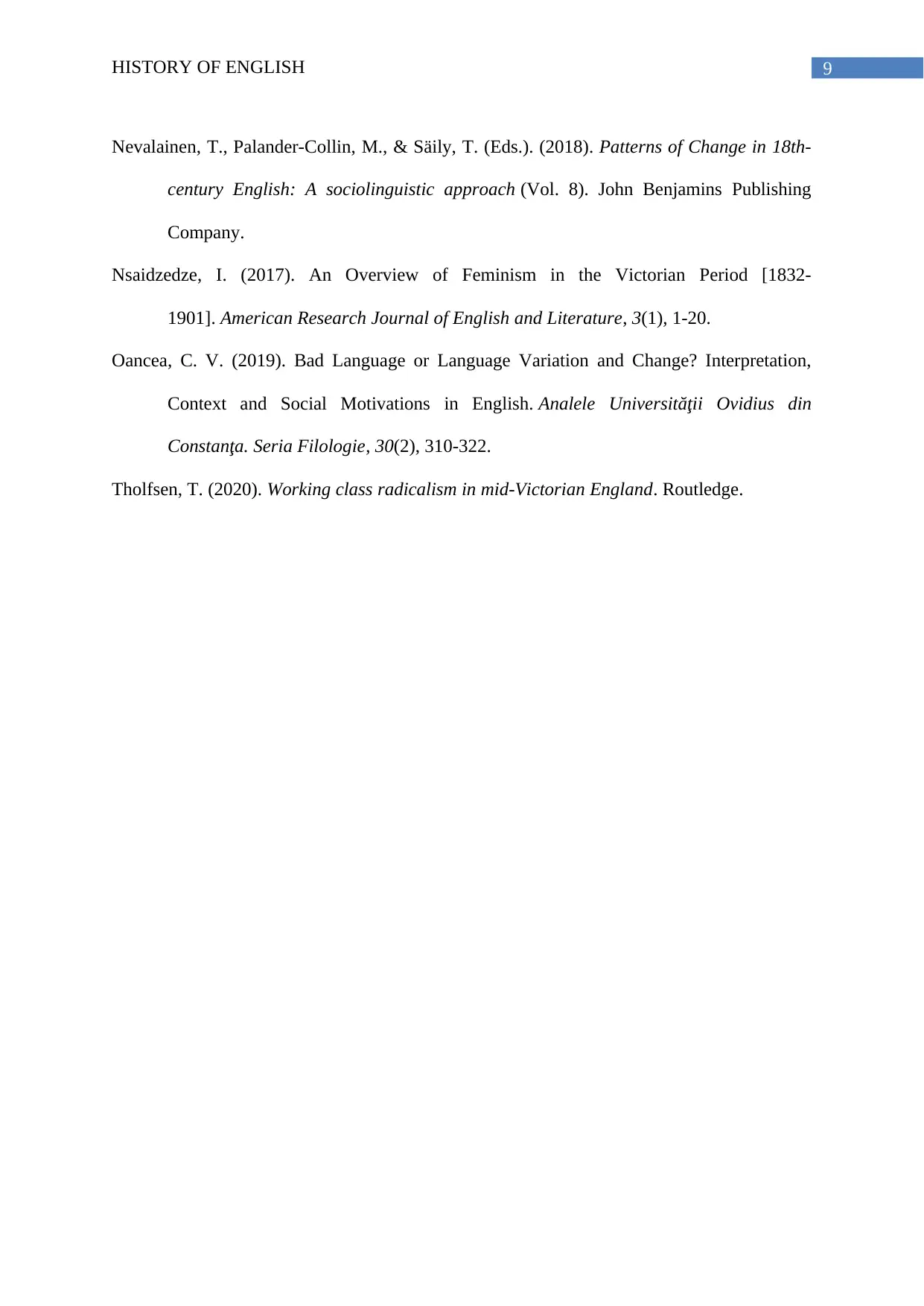
9HISTORY OF ENGLISH
Nevalainen, T., Palander-Collin, M., & Säily, T. (Eds.). (2018). Patterns of Change in 18th-
century English: A sociolinguistic approach (Vol. 8). John Benjamins Publishing
Company.
Nsaidzedze, I. (2017). An Overview of Feminism in the Victorian Period [1832-
1901]. American Research Journal of English and Literature, 3(1), 1-20.
Oancea, C. V. (2019). Bad Language or Language Variation and Change? Interpretation,
Context and Social Motivations in English. Analele Universităţii Ovidius din
Constanţa. Seria Filologie, 30(2), 310-322.
Tholfsen, T. (2020). Working class radicalism in mid-Victorian England. Routledge.
Nevalainen, T., Palander-Collin, M., & Säily, T. (Eds.). (2018). Patterns of Change in 18th-
century English: A sociolinguistic approach (Vol. 8). John Benjamins Publishing
Company.
Nsaidzedze, I. (2017). An Overview of Feminism in the Victorian Period [1832-
1901]. American Research Journal of English and Literature, 3(1), 1-20.
Oancea, C. V. (2019). Bad Language or Language Variation and Change? Interpretation,
Context and Social Motivations in English. Analele Universităţii Ovidius din
Constanţa. Seria Filologie, 30(2), 310-322.
Tholfsen, T. (2020). Working class radicalism in mid-Victorian England. Routledge.
1 out of 10
Your All-in-One AI-Powered Toolkit for Academic Success.
+13062052269
info@desklib.com
Available 24*7 on WhatsApp / Email
![[object Object]](/_next/static/media/star-bottom.7253800d.svg)
Unlock your academic potential
Copyright © 2020–2025 A2Z Services. All Rights Reserved. Developed and managed by ZUCOL.
